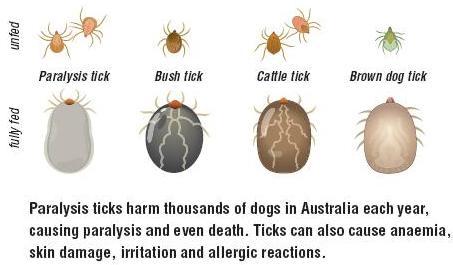
Ticks work as carriers of a variety of diseases in animals, including in dogs. Tick-bite paralysis, is caused by a powerful toxin that is released through the saliva of certain species of female tick and which is injected into the blood of the dog as the tick infests the skin of the canine..
(Check out Dog Fleas and Ticks All-Year Long)
The toxin directly affects the nervous system. These released toxins lower motor neuron paralysis – a loss of voluntary movement – caused by a disease of the nerves that connect the spinal cord and muscles. With lower motor neuron paralysis the muscles stay in an apparent state of relaxation.
Symptoms typically start to emerge around 6-9 days after a tick has attached to the skin of the dog. This disease is to some extent cyclic and more prevalent in the summer time in certain areas of the U.S.. However, in places where seasonal temperatures are more constantly warm, ticks may be present all through the year.

Symptoms
(info from: PetMD)
Remember that symptoms are gradual in nature. They are:
- Vomiting
- Regurgitation
- Unsteadiness
- High blood pressure
- Fast heart rate and rhythm Weakness, especially in the hind limbs
- Partial loss of muscle movements (paresis)
- Complete loss of muscle movement (paralysis), commonly seen in advanced disease state
- Poor reflexes to complete loss of reflex
- Low muscle tone (hypotonia)
- Difficulty in eating
- Disorder of voice (dysphonia)
- Asphyxia due to respiratory muscle paralysis in severely affected animals
- Excessive drooling (sialosis)
- Megaesophagus (enlarged esophagus)
- Excessive dilatation of pupil in the eye (mydriasis)

